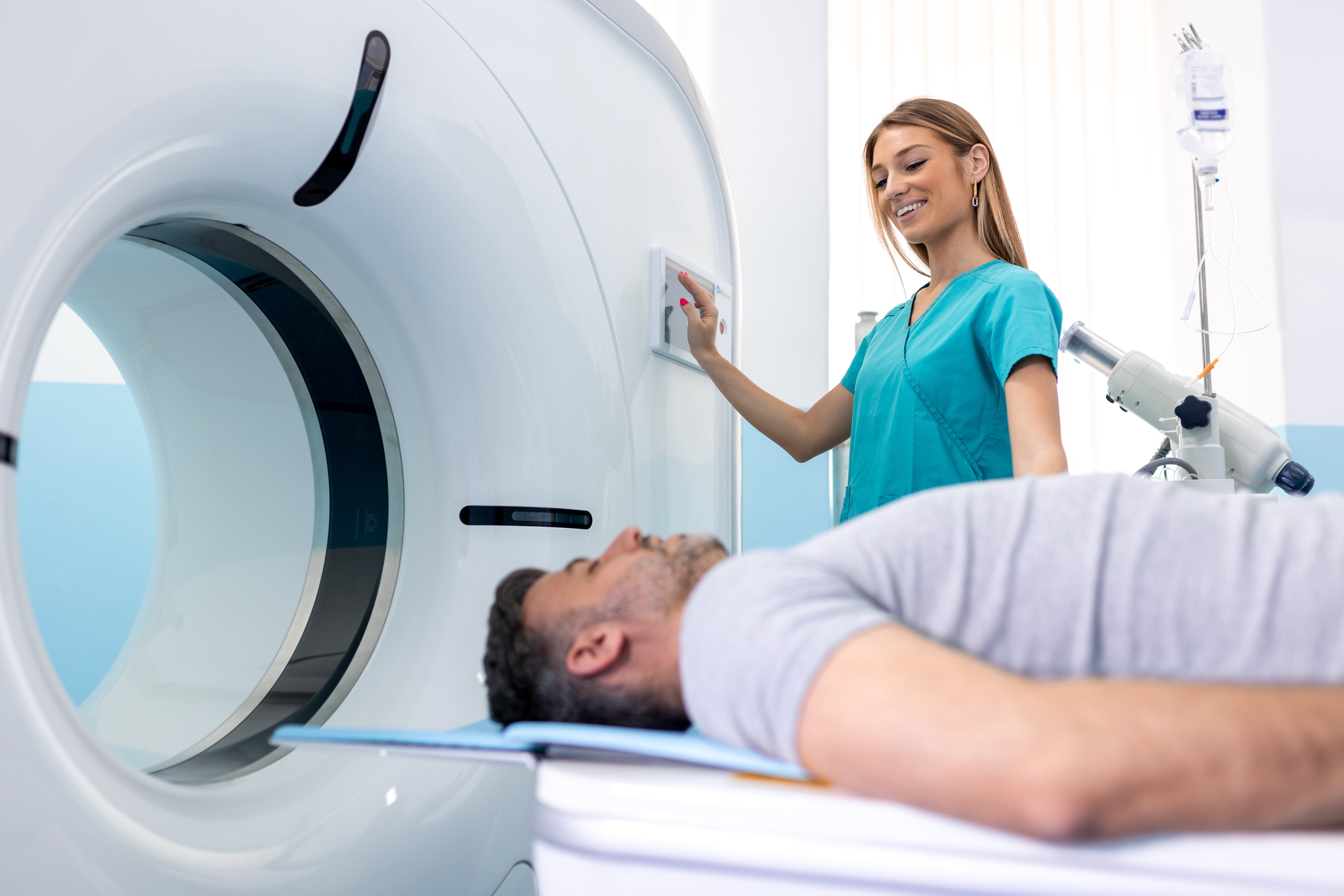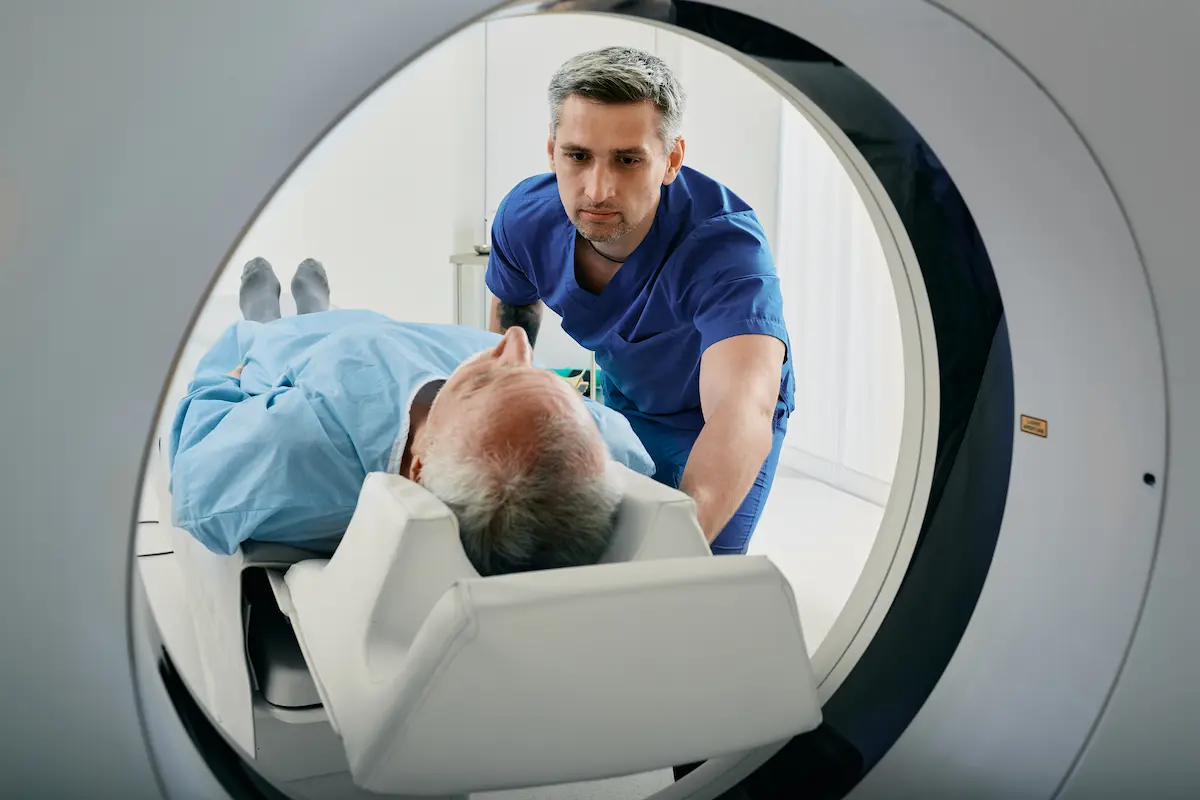If you’ve ever considered entering the field of MRI technology, Favorite Healthcare Staffing is here to support you. In this blog, we touch on everything you need to know. From MRI tech duties and responsibilities to the requirements and skills you should possess, we’ve got you covered.
- What does an MRI tech do?
- Common day-to-day tasks
- MRI techs in specialized roles: duties and responsibilities
- Rewards and challenges of being an MRI tech
- MRI tech requirements
- Common skills needed to become an MRI tech
- Search our open MRI tech jobs
What does an MRI tech do?
An MRI technologist, also known as an MRI tech, has many responsibilities within the radiology department. Their biggest responsibility is capturing quality, detailed images of the internal structures of their patients so that radiologists can properly diagnose medical conditions. MRI techs are crucial to this process because without these images, patients would go undiagnosed, which can be detrimental if they need to be treated promptly.
Other MRI tech responsibilities include comforting distressed patients, monitoring the patients and images during the MRI process, assisting radiologists, and much more. Below, you’ll find common tasks that MRI techs complete daily.
Common day-to-day tasks
While every day can look different for an MRI tech, there are tasks that they will typically perform on a day-to-day basis. These include:
- Talking with patients to inform them of the MRI procedure
- Listening to patients’ concerns
- Reassuring and comforting distressed patients throughout the process
- Ensuring the safety of each patient
- Prepping patients for their MRI procedures
- Positioning patients in the MRI machines
- Monitoring the images during the procedure
- Recording and documenting patient records and information
- Scheduling patients’ MRI procedures
- Assisting radiologists with result interpretation and diagnosis
- Administering intravenous contrast agents
- Maintaining a clean work environment
- Identifying and resolving technical issues with the equipment
- Collaborating with other medical professionals
MRI techs in specialized roles: duties and responsibilities
Pediatric MRI
Common tasks for someone in this specialty include:
- Helping pediatric patients understand how the MRI process works
- Ensuring younger patients stay still during the scan
- Calming patients' nerves if they are apprehensive about the scan
- Capturing the MRI scan images
Interventional MRI
If you choose to work in this specialty, common tasks will include:
- Assisting radiologists with minimally invasive procedures such as biopsies or catheter installations
- Monitoring the MRI scan images
- Helping radiologists with determining a diagnosis
Magnetic resonance safety officer (MRSO)
An MRSO’s main duties and responsibilities consist of:
- Enforcing safety protocols
- Minimizing risks in the radiology department
- Educating staff members and patients on MRI safety practices
- Ensuring safety protocols are being followed
Your guide to becoming an MRI tech
Learn more about the requirements, average salary, career path, and more for MRI technologists with our blog.
-1.jpeg)
Rewards and challenges of being an MRI tech
MRI techs often share that they enjoy working in this field because they get to learn and observe the work of radiologists and physicians. If you’re the type of person who prefers working with mentors and being able to learn and grow in your career, you might consider the field of MRI technology. Another reward for someone in this role is the ability to help treat patients by capturing the images that radiologists use to diagnose patients' illnesses. When caught early, patients have a much better chance of living a normal life after treatment.
Some challenges that MRI techs have encountered with this role include physical demands. Since MRI techs spend most of the day on their feet, this is something to consider before entering the profession. Additionally, some MRI techs find it to be a challenge when they have a patient who is anxious about tight spaces. However, once the patient has successfully completed the MRI scan, the feeling can be rewarding for both the patient and the MRI tech. With that said, below you’ll find the steps and skills needed to become an MRI technologist.
MRI tech requirements
Education
If you’re interested in becoming an MRI technologist, you’ll first need to earn your associate’s degree in either radiologic technology or a field related to it.
Getting your associate’s degree takes about two years to complete and will consist of a variety of courses, such as MRI imaging techniques, patient care, advanced anatomy classes, and more.
You might also want to consider getting your bachelor's degree and extra certifications, as some employers prefer MRI techs with more education and training. By undergoing this additional training, you can improve your job prospects and earnings. A bachelor's degree typically takes four years to complete, where you’ll learn all the necessary technical skills and gain plenty of hands-on experience.
Once you’ve completed either your associate’s or bachelor’s degree, you need to become certified in MRI technology. To do this, you’ll need to pass an exam administered by an accredited body, such as the American Registry of Radiologic Technologists (ARRT).
Experience
Gaining experience is especially important when becoming an MRI tech, as it allows for more practical and hands-on learning opportunities where you can practice your skills in a controlled setting. The program you enroll in will require you to complete a certain number of hours of training experience in your clinicals.
During clinicals, you’ll be able to learn how to properly operate an MRI machine, perform an MRI scan, provide patient care, interpret the images from the MRI scan, and much more. Your time in clinicals will boost your patient care abilities and technical skills to a whole new level, so it’s important to give them your all. MRI techs who prioritize the quality of patient care they provide are more valuable to healthcare facilities.
Certifications
As previously stated, you’ll need to get certified by a recognized organization such as the American Registry of Radiologic Technology (ARRT) to become an MRI technologist. To gain your certification, you need a passing score on the ARRT exam that is specifically for MRI technology.
If you want to enhance your job prospects, you might also consider the following certifications. These certifications will not only make you more valuable to employers, but you will also have the opportunity to earn higher pay:
- The Magnetic Resonance Medical Director (MRMD) certification
- The American Registry of Magnetic Resonance Imaging Technologists (ARMRIT) certification
- The Magnetic Resonance Safety Expert (MRSE) certification
Licenses
After you earn the ARRT certification, you’ll obtain your license to start practicing as an MRI technologist. Be sure to learn about the requirements for the state you work in, as they can differ from location to location. Also, depending on the state you work in, your license will only be valid for one to three years. To maintain your license, you’ll want to make sure you stay up to date and complete the required continuing education units necessary so that your license doesn’t expire.
Common skills needed to become an MRI tech
Soft skills you’ll need:
- Empathetic and compassionate attitude
- Critical thinking
- Strong attention to detail
- Collaborative skills
- Effective communication
Since some people might be nervous about having an MRI scan, especially children and those with claustrophobia, it’s essential that you possess the skill to be empathetic and compassionate. You’ll also need to be very attentive to detail since part of your job is interpreting MRI scans.
Hard skills you’ll need:
- Computer and technological skills
- Anatomy and physiology knowledge
- Being able to operate the MRI equipment
- Strong understanding of the MRI images and how to interpret them
- Patient safety
While the soft skills are important for MRI technologists to have, you’ll also need to ensure you have all the necessary technical skills to work in this field. As you might assume, you’ll need a strong foundation of knowledge when it comes to anatomy and physiology. Additionally, understanding all of the intricacies of the MRI equipment is just as important for someone to be successful in this role.
Search our open MRI tech jobs
We hope this blog has taught you more about MRI tech duties and responsibilities. If you think you possess the qualities that are needed to become an MRI technologist, we encourage you to consider entering this growing field. Looking to start your next MRI technologist dream job with Favorite? Search our open MRI tech jobs today!
Ready to start your career with Favorite?
We offer clinical and non-clinical positions for a wide variety of job types, such as per diem, permanent placement, local and travel contracts, and more.



.jpeg)


